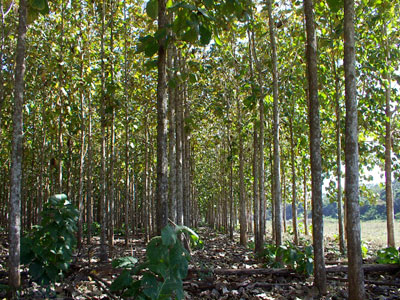|
|
TEAK - Quality and rustic aspect are nice to the market
30/11/2005
Tectona grandis, popularly know as teak, is a big size tree, native of tropical forests at the 10th and 25th North on the Indian subcontinent and in the Southeast asia mainly in India, Burma, Thailand, Laos, Cambodia, Vietnam and java, Due to the geographical dispersion and to the variety of environments where it naturally occurs, teak is a highly adaptable species with vertical dispersion between 0 and 1,300 mm over the sea level, occurring in areas with rain rate over 800-2,500 mm per year, and extreme temperatures of 2-42C, but it does not resist to frosts.

Tectona grandis L.f. belong to the botanical family of Verbenaceae. A large to very large deciduous tree having height up to 35 meters; bark having brown or gray color and shallow longitudinal furrows; Leaves simple, opposite, broadly elliptical or obovate, acute or acuminate, coriaceous, possessing minute glandular dots; Flowers white, many, small, having pleasant smell, in large erect terminal branched tomentose cymose bladder like calyx; seeds usually 1-3, ovate, marble white.
Teak exhibits a wide range of colors when fresh cut, from pale yellows to orange browns with darker striping, all of which mellows into medium brown tones. Teak undergoes an extreme degree of color change with pronounced color change from the highly variegated coloring found in material fresh sanded which then darkens to a golden brown with substantial muting of the initial color range over time. It is one of the worlds most stable woods. It is known to have adverse reaction reactions when many oil based finishes are used with this wood. Many oil finishes will not dry properly when used on Teak. In general, most water based finishes work with it. It is known to cause both contact dermatitis and respiratory reactions when coming into contact with the dust. Care must be taken when cutting or sanding this wood. It can also be used for ship building, railways, piles in harbor, bridge-building, construction work, furniture and cabinet work. In Brazil, teak is being managed in cycles of 25 years cut, while in other countries it ranges from 60 to 80 years.
In 1986, the planted area was about 10 thousand hectares; and today only in Mato Grosso there are 50 thousand ha of plantations.
Teak requires a fertile soil, permeable, well drained and with high water retention. A study revealed that teak better develops with a wealthy soil, organic material and maximum pH close to neutral factor Teak needs calcium in its soil.
When the option is to produce plants by seeding it has to be taken the care of quality of them.
The world production is about 3 million of cubic meters per year, being the biggest share consumed by the internal market of the producers. International market consumes about 500 thousand cubic meters, but the offer is still smaller then the demand.
According to marketing analyses, there will be a demand growth due to the improvement of the standard of life in developing countries. The diminishing of offer of other tropical wood in natural areas (like mahogany) and the environmental awareness of the consumers, mainly the Europeans, are also decisive factors to the increase of the teak demand.
Brazilian market is also seen as a big potential of consume as well as the production. So Brazil has adequate areas for teak plantation and a tropical forest to preserve.
The biggest producers are Indonesia, Myanmar and Sri Lanka and the biggest importers are Germany, Saudi Arabia, Australia, Denmark, Arabic Emirates, USA, Japan, Holland, Italy and United Kingdom.
Hong Kong and Singapore are manufacturing centers and re-export teak to Myanmar. India and Thailand besides producing have started to import too. | |